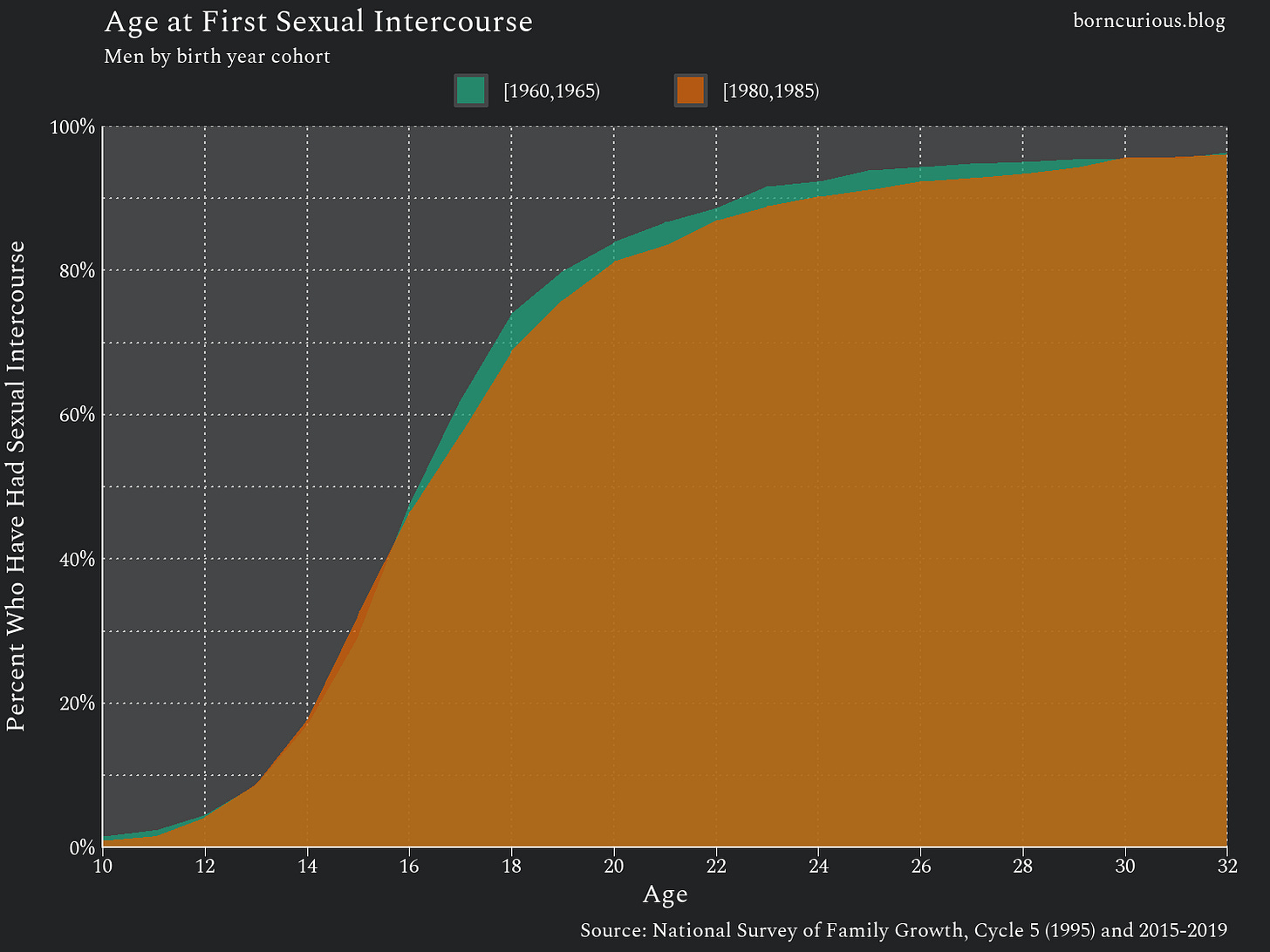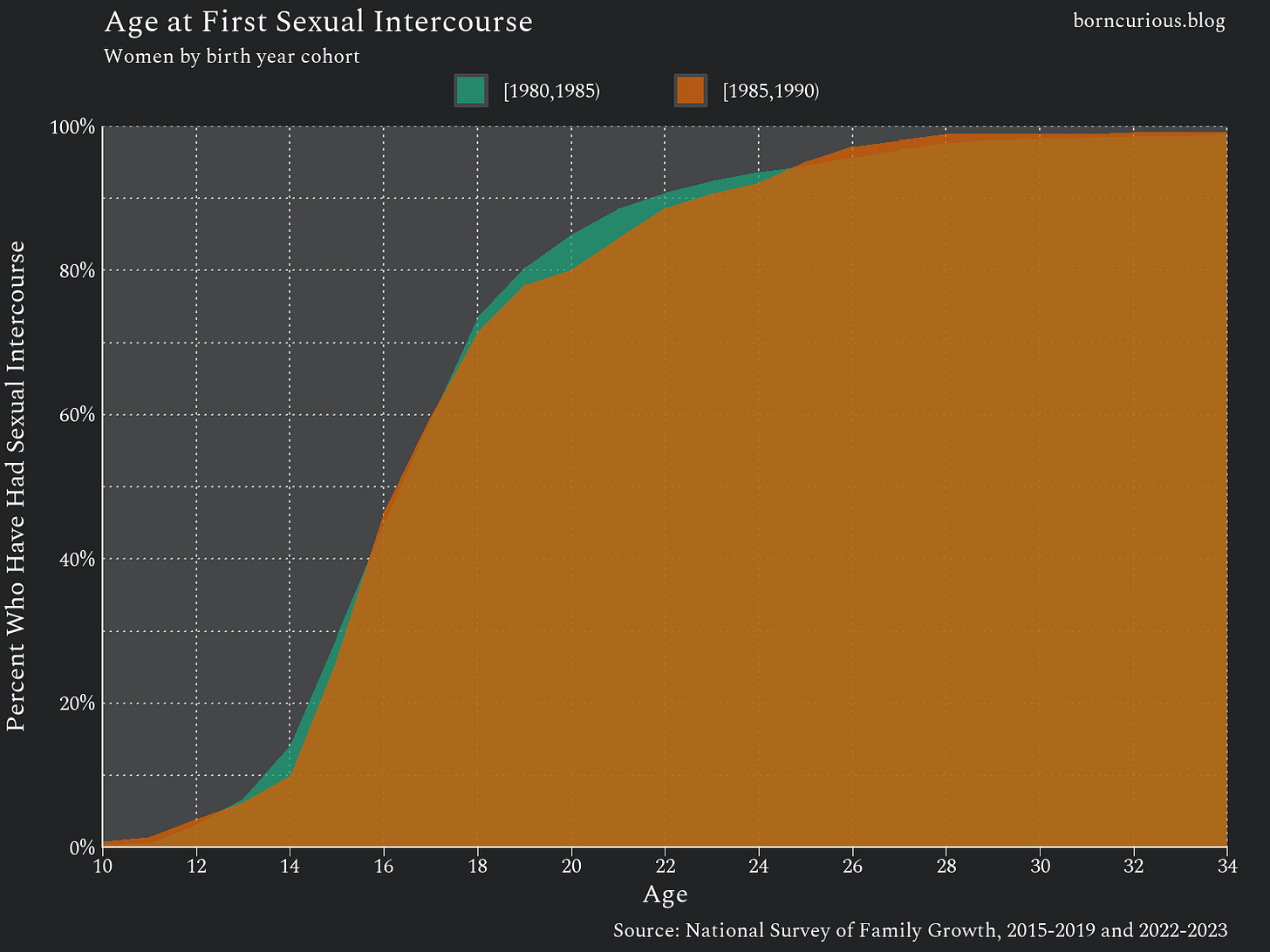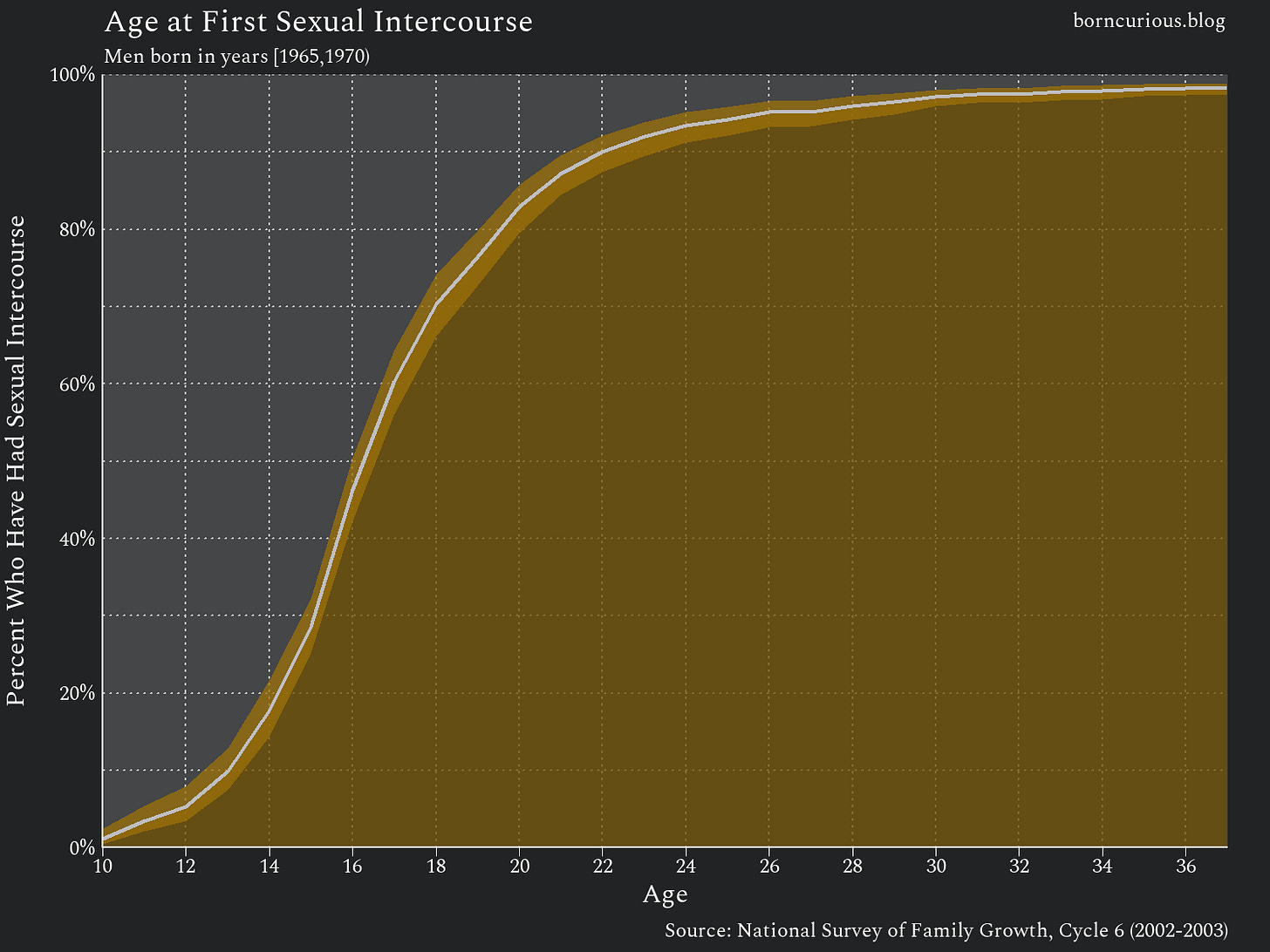At What Age Do Americans Have Sex for the First Time?
It has been suprisingly consistent for a few generations now.
Much has been made about the so-called “sexual recession” in the United States (and elsewhere). This is a phenomenon in which a greater proportion of young people are sexually inactive for extended periods among younger generations than among older generations.
For instance, Jean Twenge — psychologist and author of the book Generations — was writing about this topic as early as 2015, finding that,
15 percent of 20-to-24-year-olds born in the 1990s have not had sex since turning 18, compared to only 6 percent of comparable young adults born in the late 1960s—more than twice as many.
Numerous articles have been written on this topic for the Institute for Family Studies by authors such as
and Nicholas H. Wolfinger.It remains to be seen if this phenomenon is substantial enough to have an effect on rates of unintended pregnancy, etc. Still, it hasn’t affected one aspect of Americans’ sexual behavior: when people have sexual intercourse for the first time.
Results
I used the National Survey of Family Growth (NSFG) public use files (PUFs) for this analysis. Because the NSFG is a fertility survey, most questions about timing of respondents’ first sexual activity ask specifically about heterosexual, vaginal intercourse. “Sexual intercourse” in this analysis refers to this.1
I divided respondents into cohorts by the half-decade of their birth. As you can see in Figure 1, there appears to be a trend in which subsequent generations, on average, first had sexual intercourse at gradually younger ages until the cohorts born in the 1960s.
For cohorts born in the 1960s and onward, the mean age at first sexual intercourse has stayed right around 17.5 years. The apparent deviation from this for the [1990,1995) cohorts is almost certainly due to sampling error, as alluded to by the exceptionally large confidence interval brackets around the estimates.
Of course, the mean of a distribution is only part of the story.

Figure 2 gives a more complete illustration of ages at first sexual intercourse for the most recent cohort of women for which we have good data. About 20% had sexual intercourse before age 14.5. About 60% had sexual intercourse for the first time between ages 14.5 and 19. About 18% had sexual intercourse for the first time between the ages of 18 and 30. About 1% of women in this cohort never had vaginal sexual intercourse with a man as of 2019.
The median for this distribution appears to be right around 16.5. Because the median is lower than the mean (~17.5), it is a right-skewed distribution. The distribution is dense between ages 14 and 18, but with a long tail of individuals who have intercourse for the first time in their late teens or twenties.
Distributions for other cohorts look remarkably similar. They are included in the appendix for the sake of completeness.
Let’s compare the [1945,1950) and [1960,1965) cohorts.
The “S” shapes of the curves for the two cohorts are similar, with the [1960,1965) curve just shifted to the left. Generally, it looks like women gradually started having sexual intercourse at a younger average age during the Baby Boom generation, but with the same overall pattern.
Comparison plots for [1960,1965) and [1980,1985) — the last cohort for which we have good data — show a lot of overlap.
Generally, the distribution of ages at first sexual intercourse has been stable for generations of Americans born after 1960.
Discussion
The age at which people start engaging in sexual activity can potentially be a factor in rates of unintended pregnancy because people are at their most fecund when they are young — at the same time that they tend to be their most reckless.
The average age of first sexual intercourse reached a minimum for women born in the 1960s. This generation lived through their teens when unintended rates in the 1970s and early 1980s were soaring. Perhaps the trend toward younger ages at sexual intercourse affected this increase in unintended pregnancy.
One thing that can be certain, however, is that trends in age at first sexual intercourse did not have anything to do with the increase and subsequent decline in teen pregnancies in the 1990s. We know this because there was virtually no change in age at first sexual intercourse among cohorts who reached their teens before, during, and after the 1990s.
Data Sources and Methods
Cycles 1 and 2 of the NSFG surveyed women who had ever been married, which would give biased results for this analysis, so I did not include them. Cycle 3 of the NSFG surveyed women regardless of marital status, but it had a very high rate of missing answers to the question about age at first sexual intercourse,2 so I elected not to use it. Therefore, I use Cycle 4 and onward for this analysis.
Men were first surveyed in Cycle 5 of the NSFG, which is why I have results for more cohorts of women than men.
Because this analysis does not specifically pertain to pregnancy outcomes, I used the analysis weights provided with the PUFs instead of weights adjusted for abortion under-reporting.
Later iterations of the NSFG bottom-code the answers for age at first sexual intercourse to 10 years old for disclosure risk reduction.3 For consistency, I performed this bottom-coding retroactively on earlier iterations of the NSFG in this analysis.4 However, the number of people who have sexual intercourse before age 10 is minimal, so this should not change the substance of the results.
The month and year of a respondent’s birth were available in the PUF for earlier iterations of the NSFG, but this information was removed from the PUF for disclosure risk reduction starting in the 2011-2013 iteration of the NSFG. For 2011 and onward, I calculated a presumptive birth year for respondents based on their age at the time of their interview and the month that their interview occurred.
There are issues with the 2022-2023 iteration of the NSFG, specifically with the responses that used the new online mode instead of traditional face-to-face interviewing, so I only use face-to-face responses from the 2022-2023 NSFG. I will address the issues I found with the 2022-2023 NSFG in a separate article.
The distributions of ages at first sexual intercourse for face-to-face respondents to the 2022-2023 NFSG look very similar to the distributions for respondents to the 2015-2019 NSFG, so the face-to-face responses, at least, should be fine.
In the two plots above, the [1980,1985) cohort estimates are taken from the 2015-2019 NSFG, and the [1985,1990) estimates are from just the face-to-face responses to the 2022-2023 NSFG.
Conclusion
The average age that American women first had vaginal sexual intercourse with a man gradually got younger for women born from 1945 to 1960. For generations of both women and men born from 1960 onward, the average age of first heterosexual, vaginal intercourse has remained the same (mean ~17.5 years, median ~16.5 years).
The shapes of the distributions of ages at first sexual intercourse have been consistent throughout this whole period. Generally, most Americans engage in sexual intercourse for the first time in their teens, but a substantial minority (~20%) do not do so until their twenties.
Trends in age at first sexual intercourse might have somewhat affected the soaring of unintended pregnancy rates in the 1970s and early 1980s, but had no effect on changes in unintended pregnancy rates thereafter because there has been virtually no change in age at first sexual intercourse among recent generations.
Appendix: Plots for All Birth Cohorts
Women
Men
The later iterations of the NSFG do have questions about homosexual activity and sexual activity other than vaginal intercourse. I may do follow-up analyses on comparing age of first homosexual relations with age of first heterosexual relations and on age of first oral sex versus first vaginal sex, using just the later iterations of the NSFG that ask these questions.
There were 4,035 respondents with answers to the question on when they had sexual intercourse for the first time, but 2,727 are marked as “date refused, “date unknown,” or “date not ascertained” in the Cycle 3 PUF.
That is, any respondent who gave an answer that they first had sexual intercourse at an age younger than 10 have an answer of “10” in the PUF, in these later iterations. Disclosure-risk reduction is done to prevent a specific respondent from being personally identified based on the respondent’s answers.
For the record, I used the VRY1STAG variable from Cycle 5 of the NSFG and onward, and I used the C6 variable from Cycle 4 of the NSFG.























